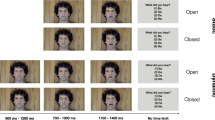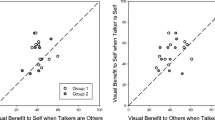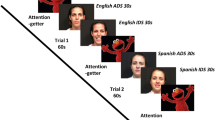Abstract
Audiovisual speech perception was studied in adults with Asperger syndrome (AS), by utilizing the McGurk effect, in which conflicting visual articulation alters the perception of heard speech. The AS group perceived the audiovisual stimuli differently from age, sex and IQ matched controls. When a voice saying /p/ was presented with a face articulating /k/, the controls predominantly heard /k/. Instead, the AS group heard /k/ and /t/ with almost equal frequency, but with large differences between individuals. There were no differences in gaze direction or unisensory perception between the AS and control participants that could have contributed to the audiovisual differences. We suggest an explanation in terms of weak support from the motor system for audiovisual speech perception in AS.



Similar content being viewed by others
Notes
Note that for the behavioral results, all 16 participants of both groups were included in the analysis in order to maximize the group size. An analysis of the behavioral results of those 9 AS participants and 14 control participants who were excluded from the eye gaze analysis gave the same statistically significant results as the analysis with all 16 participants. The eye gaze results were similar when an analysis was conducted for the matched 9 AS and 9 control participant pairs.
References
American Psychiatric Association. (1994). Diagnostic and Statistical Manual of Mental Disorders (DSM-IV) (4th ed.). Washington, DC: APA.
Andersen, T. S., Tiippana, K., Laarni, J., Kojo, I., & Sams, M. (2009). The role of visual spatial attention in audiovisual speech perception. Speech Communication, 51, 184–193.
Attwood, T. (1998). Asperger’s syndrome: A guide for parents and professionals. London: Jessica Kingsley Publishers Ltd.
Ayres, A. J. (1979). Sensory integration and the child. Los Angeles: Western Psychological Association.
Baron-Cohen, S., Wheelwright, S., Hill, J., Raste, Y., & Plumb, I. (2001). The ‘reading the mind in the eyes’ test revised version: A study with normal adults, and adults with Asperger syndrome or high-functioning autism. Journal of Child Psychology and Psychiatry, 42, 241–252.
Brancazio, L., & Miller, J. L. (2005). Use of visual information in speech perception: Evidence for a visual rate effect both with and without a McGurk effect. Perception & Psychophysics, 67(5), 759–769.
Buchan, J. N., Paré, M., & Munhall, K. G. (2007). Spatial statistics of gaze fixations during dynamic face processing. Social Neuroscience, 2(1), 1–13.
Cattaneo, L., Fabbri-Destro, M., Boria, S., Pieraccini, C., Monti, A., Cossu, G., et al. (2007). Impairment of actions chains in autism and its possible role in intention understanding. Proceeding of the National Academy of Sciences of the United States of America, 104(45), 17825–17830.
Dalton, K. M., Nacewicz, B. M., Johnstone, T., Schaefer, H. S., Gernsbacher, M. A., Goldsmith, H. H., et al. (2005). Gaze processing and neural circuitry of face processing in autism. Nature Neuroscience, 8(4), 519–526.
De Gelder, B., Vroomen, J., & van der Heide, L. (1991). Face recognition and lip-reading in autism. European Journal of Cognitive Psychology, 3, 69–86.
Ehlers, S., Gillberg, C., & Wing, L. (1999). A screening questionnaire for Asperger syndrome and other high-functioning autism spectrum disorders in school age children. Journal of Autism and Developmental Disorders, 29(2), 129–141.
Frith, U. (1992). Autism and Asperger syndrome. Cambridge: Cambridge University Press.
Frith, U. (2004). Emanuel Miller lecture: Confusions and controversies about Asperger syndrome. Journal of Child Psychology and Psychiatry, 45, 672–686.
Grandin, T., & Scariano, M. M. (1992). Minun tarinani—Ulos autismista [Emergence: Labelled autism]. Jyväskylän yliopiston täydennyskoulutuskeskus, Jyväskylä.
Iacoboni, M., & Dapretto, M. (2006). Mirror neuron system and the consequences of its dysfunction. Nature Reviews Neuroscience, 7, 942–951.
Iarocci, G., & McDonald, J. (2006). Sensory integration and the perceptual experience of persons with autism. Journal of Autism and Developmental Disorders, 36(1), 77–90.
Irwin, J. R. (2007). Auditory and audiovisual speech perception in children with autism spectrum disorders. Acoustics Today, 3(4), 8–15.
Kätsyri, J., Saalasti, S., Tiippana, K., von Wendt, L., & Sams, M. (2008). Impaired recognition of facial emotions from low-spatial frequences in Asperger syndrome. Neuropsychologia, 46, 1888–1897.
Keane, B. P., Rosenthal, O., Chun, N., & Shams, L. (2010). Audiovisual integration in high functioning adults with autism. Research in Autism Spectrum Disorders, 4, 276–289.
Kirchner, J. C., Hatri, A., Heekeren, H., Dziobek, I. (2010). Autistic symptomatology, face processing abilities, and eye fixation patterns. Journal of Autism and Developmental Disorders (epub ahead of print). doi 10.1007/s10803-010-1032-9.
Klin, A., Jones, W., Schultz, R., Volkmar, F., & Cohen, D. (2002a). Defining and quantifying the social phenotype in autism. American Journal of Psychiatry, 159(6), 895–908.
Klin, A., Jones, W., Schultz, R., Volkmar, F., & Cohen, D. (2002b). Visual fixation patterns during viewing of naturalistic social situations as predictors of social competence in individuals with autism. Archives of General Psychiatry, 59, 809–816.
Klin, A., Volkmar, F. R., & Sparrow, S. S. (2000). Diagnostic issues in Asperger syndrome. In A. Klin, F. R. Volkmar, & S. S. Sparrow (Eds.), Asperger syndrome (pp. 25–71). New York: The Guilford Press.
Liberman, A. M., & Mattingly, I. G. (1985). The motor theory of speech perception revised. Cognition, 21, 1–36.
Lord, C., Rutter, M., Goode, S., Heemsbergen, J., Jordan, H., Mawhood, L., et al. (1989). Autism diagnostic observation schedule: A standardized observation of communicative and social behavior. Journal of Autism and Developmental Disorders, 19(2), 185–212.
Lord, C., Rutter, M., & Le Couteur, A. (1994). Autism diagnostic interview-revised: A revised version of a diagnostic interview for caregivers of individuals with possible pervasive developmental disorders. Journal of Autism and Developmental Disorders, 24, 659–685.
Massaro, D. W., & Bosseler, A. (2003). Perceiving speech by ear and eye: Multimodal Integration by children with autism. Journal of Development and Learning Disorders, 7, 111–144.
McGurk, H., & MacDonald, J. W. (1976). Hearing lips and seeing voices. Nature, 264, 746–748.
Molholm, S., & Foxe, J. (2005). Look ‘hear’, primary auditory cortex is active during lip-reading. Neuroreport, 16, 123–124.
Mongillo, E. A., Irwin, J., Whalen, D. H., Klaiman, C., Carter, A. S., & Schultz, R. T. (2008). Audiovisual processing in children with and without autism spectrum disorders. Journal of Autism and Developmental Disorders, 38(7), 1349–1358.
Neumann, D., Spezio, M. L., Piven, J., & Adolphs, R. (2006). Looking you in the mouth: Abnormal gaze in autism resulting from impaired top-down modulation of visual attention. Scan, 1, 194–202.
Nishitani, N., Avikainen, S., & Hari, R. (2004). Abnormal imitation-related cortical activation sequences in Asperger’s syndrome. Annals of Neurology, 55(4), 558–562.
Norbury, C. F., Brock, J., Cragg, L., Einav, S., Griffiths, H., & Nation, K. (2009). Eye-movement patterns are associated with communicative competence in autistic spectrum disorders. Journal of Child Psychology and Psychiatry, 50, 834–842.
Oberman, L. M., & Ramachandran, V. S. (2008). Preliminary evidence for deficits in multisensory integration in autism spectrum disorders: The mirror neuron hypothesis. Social Neuroscience, 3(3–4), 348–355.
Ojanen, V., Möttönen, R., Pekkola, J., Jääskeläinen, I. P., Joensuu, R., Autti, T., et al. (2005). Processing of audiovisual speech in Broca’s area. NeuroImage, 25(2), 333–338.
Pekkola, J., Laasonen, M., Ojanen, V., Autti, T., Jääskeläinen, I. P., Kujala, T., et al. (2006). Perception of matching and conflicting audiovisual speech in dyslexic and fluent readers: and fMRI study at 3T. NeuroImage, 29(3), 797–807.
Pelphrey, K. A., Sasson, N., Reznick, J. S., Paul, G., Goldman, B., & Piven, J. (2002). Visual scanning of faces in autism. Journal of Autism and Developmental Disorders, 32, 249–261.
Rizzolatti, G., Fadiga, L., Gallese, V., & Fogassi, L. (1996). Premotor cortex and the recognition of motor actions. Cognitive Brain Research, 3, 131–141.
Skipper, J. I., Nusbaum, H. C., & Small, S. L. (2005). Listening to talking faces: Motor cortical activation during speech perception. NeuroImage, 25(1), 76–89.
Skipper, J. I., van Wassenhove, V., Nusbaum, H. C., & Small, S. L. (2007). Hearing lips and seeing voices: How cortical areas supporting speech production mediate audiovisual speech perception. Cerebral Cortex, 17(10), 2387–2399.
Smith, E. G., & Bennetto, L. (2007). Audiovisual speech integration and lipreading in autism. Journal of Child Psychology and Psychiatry, 48(8), 813–821.
Smits, R., ten Bosch, L., & Collier, R. (1996). Evaluation of various sets of acoustic cues for the perception of prevocalic stop consonants. I. Perception experiment. The Journal of the Acoustical Society of America, 100(6), 3852–3864.
Sumby, W. H., & Pollack, I. (1954). Visual contribution to speech intelligibility in noise. The Journal of the Acoustical Society of America, 26(2), 212–215.
Taylor, N., Isaac, C., & Milne, E. (2010). A comparison of the development of audiovisual integration in children with autism spectrum disorders and typically developing children. Journal of Autism and Developmental Disorders, (Epub ahead of print). doi: 10.1007/s10803-010-1000-4.
Tiippana K., Hayes E. A., Möttönen R., Kraus N. & Sams M. (2010). The McGurk effect at various auditory signal-to-noise ratios in American and Finnish listeners. Proceedings of the AVSP2010, International Conference on Auditory-Visual Speech Processing (pp. 166–169).
Wetherill, G. B., & Levitt, H. (1965). Sequential estimation of points on a psychometric function. British Journal of Mathematical and Statistical Psychology, 18, 1–10.
Williams, D. (1992). Nowbody nowhere. New York: Times Books.
Williams, J. H. G., Massaro, D. W., Peel, N. J., Bosseler, A., & Suddendorf, T. (2004). Visual–auditory integration during speech imitation in autism. Research in Developmental Disabilities, 25, 559–575.
Wing, L. (1981). The Asperger syndrome: A clinical account. Psychological Medicine, 11(1), 115–129.
World Health Organization. (1992). International classification of diseases, 10th revision (ICD-10). Genova: WHO.
Acknowledgments
We are obliged to the participants of the study. We would like to acknowledge the contibution of the anonymous Reviewers of this paper, whose comments led to considerable improvements. We thank Tapani Suihkonen for participating in the preparation of the experiment, Tuomas Tolvanen for his help in preprocessing the eye gaze tracking data, and Jari Lipsanen for statistical advice. Eira Jansson-Verkasalo Ph.D. and Minna Laakso Ph.D. gave useful comments on the manuscript and Taina Nieminen- von Wendt MD, Ph.D. helped with her diagnostic expertise. We also thank Professor Pirkko Oittinen for providing access to the eye tracking equipment. The study was funded by Langnet, the Finnish Graduate School of Language Studies, and by the Jenny and Antti Wihuri Foundation. We dedicate this study to the memory of Professor Lennart von Wendt.
Author information
Authors and Affiliations
Corresponding author
Rights and permissions
About this article
Cite this article
Saalasti, S., Kätsyri, J., Tiippana, K. et al. Audiovisual Speech Perception and Eye Gaze Behavior of Adults with Asperger Syndrome. J Autism Dev Disord 42, 1606–1615 (2012). https://doi.org/10.1007/s10803-011-1400-0
Published:
Issue Date:
DOI: https://doi.org/10.1007/s10803-011-1400-0




